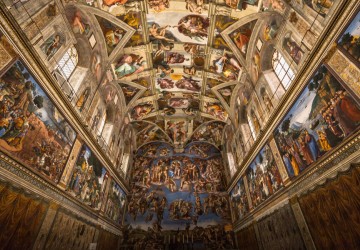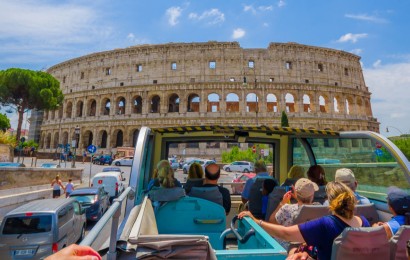The Last Judgment is one of the most famous frescoes in the world, preserved in the Sistine Chapel and realized by Michelangelo Buonarroti between 1536 and 1541. The work is in the wall behind the altar of the Sistine Chapel.
To create the fresco were sacrificed 3 previous frescoes by Perugino and two lunettes that Michelangelo himself had painted twenty years before.
If you want to admire the beauty of Michelangelo’s Last Judgment book an afternoon tour to the Vatican Museums and the Sistine Chapel and immerse yourself in the most beautiful artistic masterpieces in the world.
Brief description of Michelangelo’s The Last Judgment
The Last Judgment represents the moment of Revelation: the angels sound the trumpets while Christ in his last coming inaugurates the kingdom of Heaven.
At the center is Christ who with his right hand raised saves the blessed, while with the left condemns sinners to eternal damnation. So the damned fall to hell, while the blessed rise to Heaven
Next to him the Virgin Mary with her head turned to the left, resigned to waiting for the Judgment. Together with her, the Saints and the Elect await the verdict, from the painting you can easily recognize: Saint Peter, Saint Bartholomew, Saint Catherine, and Saint Sebastian.
Below we find the Angels of the Apocalypse who blow trumpets to awaken the dead. On the left side, the resurrected ascend to heaven to recover their bodies in view of the eternal Resurrection. On the right, angels and demons hurl the damned into hell.
Finally, at the bottom, there is the figure of Charon who, helped by demons, takes the damned off his boat to lead them before Minos, the infernal judge with the body wrapped by the serpent’s coils.
Every visitor to the Sistine Chapel is fascinated by the beauty of this work, which represents one of the most famous Renaissance paintings ever, in which the entire wall is completely destined to accommodate the entire fresco. The extraordinary pictorial ability of Michelangelo succeeded in the composition of human forms freely painted and rendered in all their anatomical and expressive strength, almost to anticipate the arrival of the Baroque artistic current.
Curiosities about Michelangelo's The Last Judgment
Let’s discover 5 curiosities about Michelangelo’s The Last Judgment:
- Michelangelo did not accept the will of Pope Clement VII to paint The Last Judgment. In fact, Buonarroti stood out more as a sculptor and that assignment filled him with enormous responsibilities.
However, he accepted the assignment and with commitment and dedication created one of the most beautiful works of the Renaissance, painting in all more than 400 figures; - The Last Judgment measures 13,7 m x 12 m, occupying 180 square meters of wall, without any frame that delimited it;
- Michelangelo, very vain, wanted to authoritarian himself in the suffering representation of Saint Bartholomew skinned alive and in which he wanted to reflect all his moods.
- Michelangelo seriously threatened to end up on trial for heresy. His fresco went against the traditional Catholic iconography and, in addition to showing nudity, the chaotic setting of the composition was also worrying. In 1564 the year after his death, the Council of Trent commissioned the artist Daniele da Volterra to cover the nude figures of the Last Judgment;
- The painting contains many mythological figures, inspired by Dante’s Divine Comedy and marking on an artistic level, the beginning of a new era and artistic adherence to the Renaissance.

